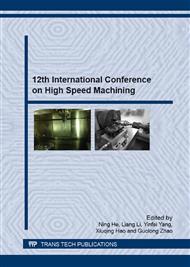[1]
Trent, E. M, and Paul Kenneth Wright. Metal Cutting: Fourth Edition. 4th ed. United States: Butterworth Heinemann, (2000).
Google Scholar
[2]
David A. Stephenson. Metal Cutting Theory and Practice., CRC Taylor & Francis, (2006).
Google Scholar
[3]
Pigott, R.J.S., and A.T. Colwell. Hi-Jet System for Increasing Tool Life., SAE Technical Papers, 1952. doi: 10. 4271/520254.
DOI: 10.4271/520254
Google Scholar
[4]
Iyengar, H. S. Rama, R. Salmon, and W. B. Rice. Some Effects of Cutting Fluids on Chip Formation in Metal Cutting., Journal of Manufacturing Science and Engineering 87, no. 1 (February 1, 1965): 36–38. doi: 10. 1115/1. 3670754.
DOI: 10.1115/1.3670754
Google Scholar
[5]
Sharma, C. S., W. B. Rice, and R. Salmon. Some Effects of Injecting Cutting Fluids Directly Into the Chip-Tool Interface., Journal of Manufacturing Science and Engineering 93, no. 2 (May 1, 1971): 441–44. doi: 10. 1115/1. 3427947.
DOI: 10.1115/1.3427947
Google Scholar
[6]
Mazurkiewicz, M., Z. Kubala, and J. Chow. Metal Machining With High-Pressure Water-Jet Cooling Assistance—A New Possibility., Journal of Manufacturing Science and Engineering 111, no. 1 (February 1, 1989): 7–12. doi: 10. 1115/1. 3188736.
DOI: 10.1115/1.3188736
Google Scholar
[7]
Ezugwu, EO, Ar Machado, IR Pashby, and J Wallbank. The Effect Of High-Pressure Coolant Supply When Machining A Heat-Resistant Nickel-Based Superalloy., Lubric. Eng. 47, no. 9 (1991): 751–57.
DOI: 10.1080/10940349808945655
Google Scholar
[8]
R.R. Lindeke, F.C. Schoenig, A.K. Khan, & J. Haddad. Machining of Alpha-Beta Titanium with Ultra-High Pressure Through the Insert Lubrication/Cooling., Transactions of the North American Manufacturing Research Institution of SME, Society of Manufacturing Engineers, 1991, 154–61.
Google Scholar
[9]
Wertheim, R., J. Rotberg, and A. Ber. Influence of High-Pressure Flushing through the Rake Face of the Cutting Tool., CIRP Annals - Manufacturing Technology 41, no. 1 (1992): 101–6. doi: 10. 1016/S0007-8506(07)61162-7.
DOI: 10.1016/s0007-8506(07)61162-7
Google Scholar
[10]
Shoenig, F.C. Machining of the Titanium Using Waterjet Assistance through the Insert., Proceedings of the Seventh American Waterjet Conference, Seattle, (1993).
Google Scholar
[11]
A. R. Machado, and J Wallbank. The Effect of a High-Pressure Jet on Machining., Proc Instn Mech Engrs 208 (1994).
Google Scholar
[12]
Kovacevic, R., C. Cherukuthota, and R. Mohan. Improving Milling Performance with High-Pressure Waterjet Assisted Cooling/Lubrication., Journal of Engineering for Industry-Transactions of the Asme 117, no. 3 (August 1995): 331–39. doi: 10. 1115/1. 2804338.
DOI: 10.1115/1.2804338
Google Scholar
[13]
Kaminski, J, and B Alvelid. Temperature Reduction in the Cutting Zone in Water-Jet Assisted Turning., Journal of Materials Processing Technology 106, no. 1–3 (October 31, 2000): 68–73. doi: 10. 1016/S0924-0136(00)00640-3.
DOI: 10.1016/s0924-0136(00)00640-3
Google Scholar
[14]
Ezugwu, E. O., and J. Bonney. Effect of High-Pressure Coolant Supply When Machining Nickel-Base, Inconel 718, Alloy with Coated Carbide Tools., Journal of Materials Processing Technology, Proceedings of the International Conference in Advances in Materials and Processing Technologies, 153–54 (November 10, 2004): 1045–50. doi: 10. 1016/j. jmatprotec. 2004. 04. 329.
DOI: 10.1016/j.jmatprotec.2004.04.329
Google Scholar
[15]
Çolak, O. Investigation on Machining Performance of Inconel 718 under High Pressure Cooling Conditions., Strojniski Vestnik/Journal of Mechanical Engineering 58, no. 11 (2012): 683–90. doi: 10. 5545/sv-jme. 2012. 730.
DOI: 10.5545/sv-jme.2012.730
Google Scholar
[16]
Beno.T., Lindstroem.B., Pejryd. L Improvement of Heat Transfer in Machining Operations, International Conference on Manufacturing Excellence, 13-15 October, 2003, Melbourne.
Google Scholar
[17]
White, F.M. Heat Transfer. Addison-Wesley Longman, Incorporated, (1984).
Google Scholar


